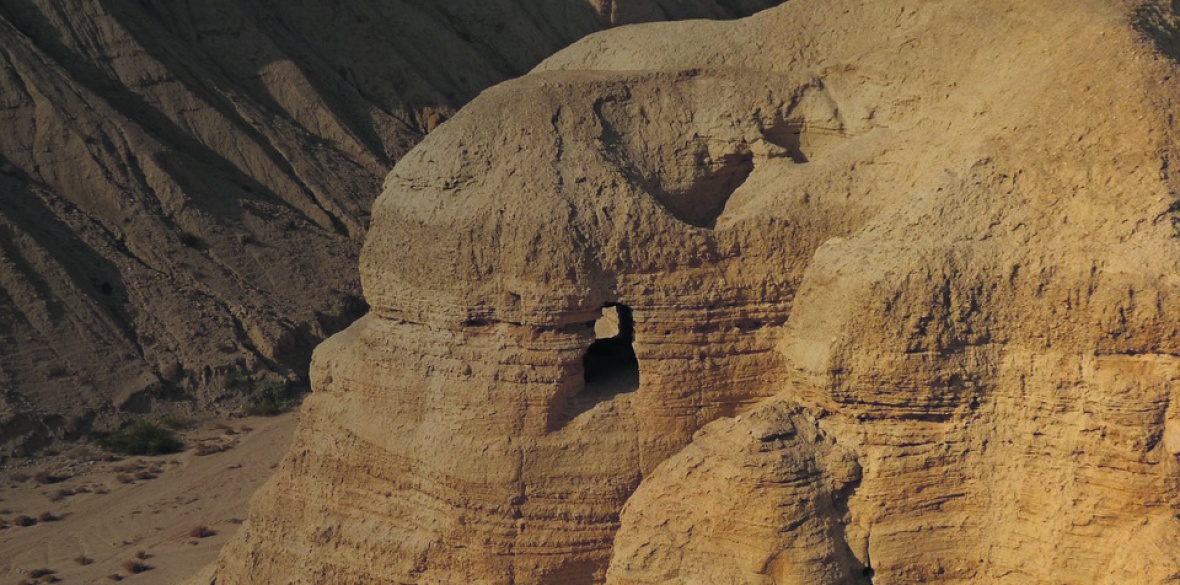This is the last article you can read this month
You can read more article this month
You can read more articles this month
Sorry your limit is up for this month
Reset on:
Please help support the Morning Star by subscribing here
THE Dead Sea Scrolls, a series of parchments discovered in the Qumran Caves in the late 1940s and early 1950s, are some of the earliest texts relating to the Bible, dating back more than 2,000 years.
As cultural artefacts, their ownership is fiercely contested. The Qumran Caves are in occupied Palestinian territory, and the scrolls were stored in the Palestine Archaelogical Museum (controlled by Jordan from 1966) until it was captured by Israel during the Six-Day War of 1967, meaning that the scrolls have been the focus of an intense three-way ownership dispute.
This month, an international collaboration of scientists reported that one particular scroll shows evidence of an unusual preparation method, suggesting that it may have been prepared outside the Dead Sea region altogether.
The Temple Scroll is almost nine metres long and just a 10th of a millimetre thick. Although made of animal skin like other Dead Sea Scrolls, it’s somewhat unusual: the text is written on the flesh side of the skin, rather than the hair side, and the surface is a light white colour, in stark contrast to other dark-coloured scrolls.
This light colour was already known to be evidence of a treated parchment surface. In a new paper published in the journal Science Advances, the scientists describe how they used a small sample of the scroll of about one square centimetre and examined this surface carefully, using techniques such as X-ray analysis.
Much as the city of London is made up of archaeological layers built up over time, the surface of a parchment such as the Temple Scroll has its own microscopic archaeology. On top of the skin’s surface rests an inorganic layer of salts, on top of which the writing in ink rests.
And like London, the surface isn’t smooth but ragged and pockmarked — due both to the preparation, when flesh and hair had to be ripped off the animal skin to make the ultra-thin parchment, and to the passage of time since. Distinguishing the signatures of the preparation process from damage accumulated over time is a complex and painstaking endeavour.
The circumstances surrounding the recovery of the Temple Scroll are almost as murky as its origins and subsequent ownership. The scientists summarise in their paper: “Allegedly, a group of Bedouins found it wrapped in cloth in a jar in 1956 in Cave 11 of Qumran and then sold it to an antiquities dealer who replaced the original encasement with cellophane and then transferred it from the jar into a shoebox that he hid under the floor in his home.”
When the Israeli army occupied East Jerusalem in 1967, the scroll was recovered from this hiding place by soldiers and confiscated from the dealer, with the Israeli government paying him $105,000 in compensation and becoming its legal (albeit contested) owners.
This unorthodox history of storage unfortunately damaged the scroll. Tempting though it must have been to see inside the brittle tightly rolled scroll, the first conservators to receive it knew that unfurling it might destroy it entirely. To unroll it, they therefore needed to first soften in by making it as moist as possible.
The danger in making parchment moist is that moisture kick-starts the process of “gelatinisation.”
Animal skin contains fibres of the protein collagen, knitting its structure together. The chemical bonds in collagen are vulnerable to molecules of water, which can break up the fibres, producing smaller proteins and turning the structured collagen into less structured gelatin (the substance used to make chewy sweets and jelly). Understandably, turning a 2,000-year-old scroll into jelly is a conservator’s worst nightmare.
To stop this process, the parchment must quickly be rapidly freeze-dried. Fortunately, the conservators did a good job, using a method proposed by British Museum conservation scientist Harold Plenderleith (who also came up with a cleaning method for the notorious — and also stolen — Elgin Marbles).
The Temple Scroll survived its first unrolling and has been analysed by several groups since; always only with the permission of the Shrine of the Book, where it is held.
In this recent work, the scientists looked in detail at the chemical composition of the light-coloured surface. They found evidence of “non-marine evaporitic mineral deposits” — salts left behind after water has evaporated, like the discolouration on a glass taken out of a dishwasher.
These could have formed during the storage of the Temple Scroll in a cave for 2,000 years. However, the chemicals included salts called glauberite and thenardite, which are not commonly found in the Dead Sea region, suggesting that the salts, and maybe the parchment, originated elsewhere — exactly where is still an open question.
They also compared the Temple Scroll’s surface to other similar light-coloured parchments found in the Qumran Caves, using samples held by the John Rylands Library in Manchester. They found a similar composition to the Temple Scroll, but a difference in continuity of the layer of salts.
The Temple Scroll’s continuous layer suggests a unique preparation process, setting it apart from the other Dead Sea Scrolls. Because the salts were “evaporitic,” this process probably involved coating the parchment with a liquid solution and then waiting for it to dry before writing on the (now treated) surface.
The author of the Temple Scroll would have been focused far more on the words they were writing — instructions for building a vast temple — than the materials they were using to do so. Yet this knowledge and the provenance of the parchment itself, which must have seemed unnecessary to write down, can now only be reconstructed partially by careful scientific study.
Nations and states have always been flexible entities which ebb and flow (and eventually disintegrate). The evidence that the Temple Scroll may have been prepared outside the region it was found in is a reminder that cultural exchange is not only a modern phenomenon.
While cultural exchange is often thought of as related to ideas, material conditions cannot be overlooked; access to new technologies via the exchange of physical objects has always defined and delimited the possibilities of human lives.
None of this is to excuse cultural appropriation. But the world is the poorer when cultural capitalists use power to restrict access to history, just as when financial capitalists restrict access to wealth.
And understanding the composition of the Dead Sea Scrolls is key to conserving them in the best possible way for the future. As the Hague Convention of 1954 relating to the destruction of cultural property during armed conflict says, “any damage to cultural property, irrespective of the people it belongs to, is a damage to the cultural heritage of all humanity.”
The original paper can be read in full at advances.sciencemag.org/content/5/9/eaaw7494.











